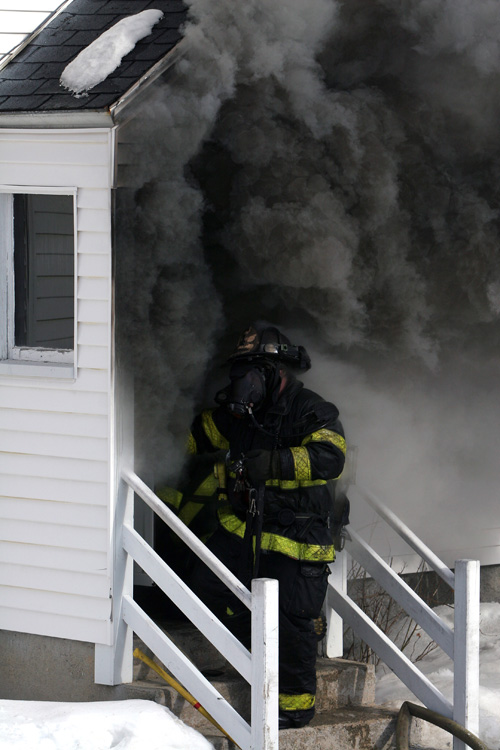Reading the Fire 4
Application of the B-SAHF (Building, Smoke, Air Track, Heat, & Flame) organizing scheme for critical fire behavior indicators to photographs or video of structure fires provides an excellent opportunity to develop your knowledge of fire behavior and skill in reading the fire. While video provides the opportunity to observe fire behavior indicators over time, still photos also an excellent tool for practice your skill in reading the fire.
Smoke Showing Photography
This Reading the Fire exercise is based on a photo taken by Scott LaPrade, a firefighter assigned to Ladder 1 in Leominster, Massachusetts. Scott has been photographing fires around New England for 25 years. His website, Smoke Showing Photography is an excellent resource when looking for fire photos to practice reading the fire.
Apartment Fire
On February 6, 2009, the Leominster Fire Department received a call for smoke in the building at 77 Cedar Street. Ladder 1 was first due and reported smoke showing from a three-story wood frame apartment building originally built in the 1900s.
Initially light smoke was showing from the roof, but then appeared to dissipate. After companies made entry to investigate, the fire progressed rapidly.
Download and print the B-SAHF Worksheet. Consider the information provided above and examine the following photo. First, describe what you observe in terms of the Building, Smoke, Air Track, Heat, and Flame Indicators. Second, answer the following six questions:
- What stage(s) may the fire be in (incipient, growth, fully developed, or decay)?
- What burning regime is the fire likely to be in (fuel or ventilation controlled)?
- What conditions would you expect to find inside the doorway in the photo?
- What hazards does the firefighter in does the firefighter in the photo face while working in the doorway?
- How could these hazards be mitigated?
- If the fire is on Floor 1 (it was), what are likely avenues for extension in this type of building construction?

Note the kink in the 1-3/4″ (45 mm) hoseline behind the firefighter. Kinks can dramatically reduce flow rate. Watch your hoseline as well as the B-SAHF indicators!
Visit Scott’s website Smoke Showing Photography for additional photos of this incident and extend your practice in Reading the Fire.

Ed Hartin, MS, EFO, MIFireE, CFO
Tags: B-SAHF, deliberate practice, FBI, fire behavior indicators, reading the fire



February 23rd, 2009 at 07:45
Based of the limited information I am assuming that this is baloon frame construction. From the statement of light smoke showing from the roof on arrival I would tend to believe the fire made the void space and ran the wall. The photo leads me to believe there is significant heat due to the turbulence in the smoke. It also appears that the fire had become vent controlled and opening up the building kicked the building back into the growth stage. Due to the amount of carbon in the smoke I would expect some type of extreme fire behavior unless the atmosphere can be cooled.
More than likely there will be significant heat at the upper level of the room but it appears the buoyancy of the smoke is still good and the lower four feet or so will be tenable with appropriate PPE.
Ultimately with aggresive tactics including appropriate ventilation (vertical and PPV in my opinion) and appropriately placed attack lines I think salvage efforts could be made to save some of the owners personal items however the fire seems to have taken control of the building and unless you have a large amount of resources to open up the walls and voids this structure will be lost.
February 23rd, 2009 at 08:09
I went and looked at the wesite with more photos and looks like this department did an amazing job.
Another thing I noticed that may be coincedence is the snow melting on the roof could be indicating that the fire has made the attic. Really interested in knowing if it did.
February 26th, 2009 at 08:22
Pat,
Good read of the B-SAHF indicators and assessment of fire conditions. Appropriate tactical ventilation is a key element of controlling fires in this type of building. However, I would be wary about use of PPV without knowing a bit more about conditions; location of the fire, possible occupants, and firefighters; as well as the current ventilation profile. I will be exploring this issue in a future post!